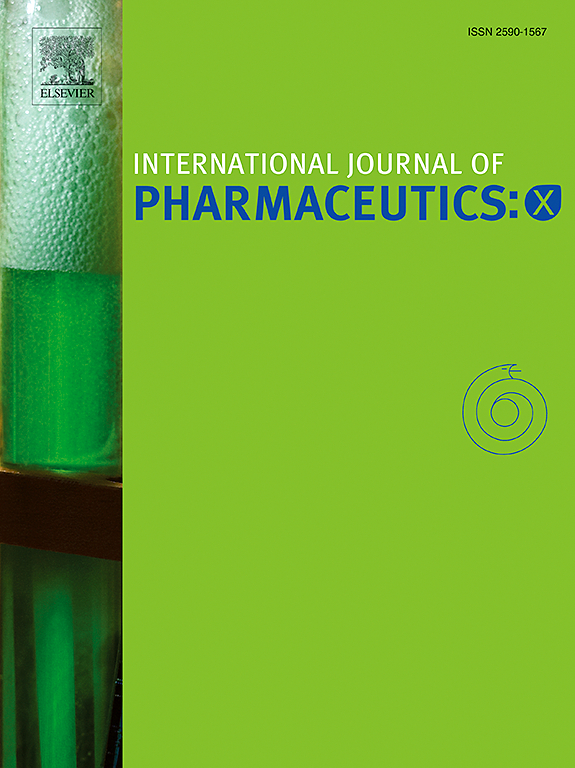Does tablet shape and height influence survival of fluidized bed-granulated living microorganisms during compaction?
IF 6.4
2区 医学
Q1 PHARMACOLOGY & PHARMACY
引用次数: 0
Abstract
The provision of effective probiotic formulations requires gentle processing to maintain the viability of the probiotic microorganisms, which is essential for their health-promoting effects. The drying of microorganisms by fluidized bed spray granulation and subsequent processing of the granules into tablets has proven to be a promising process route in previous studies of the same authors. In these, the influence of various factors was considered using cylindrical tablets with a diameter of 11.28 mm and a mass of 450 mg. These flat tablets are unpleasant to ingest and other tablet geometries should be considered for administration of probiotics but to date, no studies exist on the influence of geometric factors of the tableting tool and of the tablets on the survival of microorganisms. To address this aspect, the survival of Saccharomyces cerevisiae during the production of flat, round tablets with different tablet masses and thus heights as well as differently shaped convex tablets is determined and related to the physical-mechanical tablet properties to derive process-structure-property relationships. It turned out that higher tablet heights were advantageous regarding microbial survival and mechanical strength which is attributed to a lower elastic recovery. However, the use of differently shaped tools had a smaller influence on microbiological and mechanical tablet properties since the global tablet porosity was hardly affected.

压实过程中,片剂的形状和高度是否影响流化床颗粒化活微生物的存活?
提供有效的益生菌制剂需要温和的处理,以保持益生菌微生物的活力,这对它们的健康促进作用至关重要。在同一作者之前的研究中,流化床喷雾造粒干燥微生物并随后将颗粒加工成片剂已被证明是一种有前途的工艺路线。其中,采用直径11.28 mm、质量450 mg的圆柱形片剂,考虑了各种因素的影响。这些平板片剂令人不愉快的摄入和其他片剂的几何形状应考虑给药益生菌,但迄今为止,没有研究存在的影响的几何因素的片剂的片剂对微生物的生存。为了解决这一问题,我们测定了不同片剂质量和高度的圆形平板片剂以及不同形状的凸片剂生产过程中酿酒酵母的存活率,并将其与片剂的物理力学性质联系起来,得出了工艺-结构-性质的关系。事实证明,较高的片剂高度有利于微生物的生存和机械强度,这是由于较低的弹性恢复。然而,使用不同形状的工具对片剂的微生物学和力学性能的影响较小,因为片剂的整体孔隙率几乎没有受到影响。
本文章由计算机程序翻译,如有差异,请以英文原文为准。
求助全文
约1分钟内获得全文
求助全文
来源期刊

International Journal of Pharmaceutics: X
Pharmacology, Toxicology and Pharmaceutics-Pharmaceutical Science
CiteScore
6.60
自引率
0.00%
发文量
32
审稿时长
24 days
期刊介绍:
International Journal of Pharmaceutics: X offers authors with high-quality research who want to publish in a gold open access journal the opportunity to make their work immediately, permanently, and freely accessible.
International Journal of Pharmaceutics: X authors will pay an article publishing charge (APC), have a choice of license options, and retain copyright. Please check the APC here. The journal is indexed in SCOPUS, PUBMED, PMC and DOAJ.
The International Journal of Pharmaceutics is the second most cited journal in the "Pharmacy & Pharmacology" category out of 358 journals, being the true home for pharmaceutical scientists concerned with the physical, chemical and biological properties of devices and delivery systems for drugs, vaccines and biologicals, including their design, manufacture and evaluation. This includes evaluation of the properties of drugs, excipients such as surfactants and polymers and novel materials. The journal has special sections on pharmaceutical nanotechnology and personalized medicines, and publishes research papers, reviews, commentaries and letters to the editor as well as special issues.
 求助内容:
求助内容: 应助结果提醒方式:
应助结果提醒方式:


